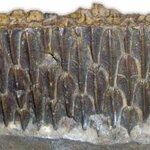Paleontology

Fossil crabs, several dozen species of mulluscs including the elusive tusk shell have been found in the fossil exposures of the Lincoln Creek Formation, southern Olympic Peninsula, near the town of Porter, Washington, 46°56'20"N, 123°18'38"W. It is a site I return to each year to see the erosion and what new specimens have worked their way to the surface. The whitish strata consists of tuffaceous siltstone and sandstone with concretionary beds throughout. They are slightly older than originally thought, coming in around 37 million-years, straddling the Eocene-…

Ancient nomadic hominids moved from place to place but often how has been subject to speculation. Now researchers think they have one answer, using the dental fossils of animals eaten by Homo heidelbergensis.
In the French cave of Arago, an international team of scientists headed by researchers from the Catalan Institute of Human Paleoecology and Social Evolution (IPHES) in Tarragona has analyzed the dental wear of herbivorous animals, the first time that an analytical method has allowed the establishment of the length of human occupations at archaeological sites. The key is the last…

Metasequoia, a deciduous conifer, and one of the common fossils found in many of the Eocene sites of the Pacific northwest, flourished in Oregon's forests for millions of years. In honor of this long history, Oregon has named it their official state fossil.
Metasequoia were first described from the Mesozoic from Shigeru Miki in 1941. Miki, thinking they were long extinct was surprised that his fossil first has living relatives. The "dawn redwood" was rediscovered in China in 1941 in Modaoxi. The excitement of the find was diminished by the heating up of World War II. In 1948, Wan…

Metasequoia, a deciduous conifer, and one of the common fossils found in many of the Eocene sites of the Pacific northwest, flourished in Oregon's forests for millions of years. In honor of this long history, Oregon has named it their official state fossil.
Metasequoia were first described from the Mesozoic from Shigeru Miki in 1941. Miki, thinking they were long extinct was surprised that his 'fossil first' had living relatives. The "dawn redwood" was rediscovered in China in 1941 in Modaoxi. The excitement of the find was diminished by the heating up of World War II. In 1948,…

Microscopic analysis of scratches on dinosaur teeth may have helped scientists unravel an ancient riddle of what a major group of dinosaurs - the Hadrosaurs - ate and exactly how they did it.
A study led by the University of Leicester has found evidence that the duck-billed dinosaurs called Hadrosaurs had a unique way of eating, unlike any living creature today. Working with researchers from the Natural History Museum, the study used a new approach to analyze the feeding mechanisms of dinosaurs and understand their place in the ecosystems of tens of millions of years ago.…

In a tale of time traveler gone bad, amateur dinosaur hunter, Nathan Murphy, the fellow who found the famous duck-billed dinosaur Leonardo in the burnt-umber badlands of Montana’s Hell Creek back in 2002, has pleaded guilty to paleontological theft. The clays, mudstones and sandstones of the Hell Creek Formation house a significant paleontological bone bed home to many Cretaceous dinosaurs, crocodylian osteoderm fragments, dermal plates of fossil gars and the archaeological remains from the Sioux, Crow and Blackfeet First Nations.
Murphy is sorry for the…
During the Miocene and Pliocene, 12-1.6 million years ago, a diverse group of extinct proboscideans, elephant-like animals walked the Earth. Most had four tusks and likely a trunk similar to modern elephants. They were beasts of legend, inspiring myths and stories of fanciful creatures to the first humans to encounter them.
One such fellow was Quintus Sertorius, a Roman statesman come general, who grew up in Umbria. Born into a world at war just two years before the Romans sacked Corinth to bring Greece under Roman rule, Quintus lived much of his life as a military man far from his native…

The largest animals ever to have walked the face of the earth just got a little smaller, according to a paper published today in the Zoological Society of London's Journal of Zoology.
Why aren't they as big as previously thought? The researchers say that the original statistical model used to calculate dinosaur mass is flawed, which led to them suggesting dinosaurs have been oversized. Widely cited estimates for the mass of Apatosaurus louisae, one of the largest of the dinosaurs, may be double that of its actual mass instead of the commonly cited 33-38 tons it may be as…

The islands of the Aegean are peaks of underwater mountains that extend out from the mainland. Crete is the last of this range and boasts a diverse beauty from its high mountains of Psiloritis, Lefka Ori, Dikti, to its ocean caressed pink sand beaches.
Much of the island of Crete is Miocene and filled with fossil mollusks, bivalves, gastropods who lived 5 to 23 million years ago in warm, tropical seas. They are easily collected from their pink limestone matrix and are often eroded out, mixing with their modern relatives. Aside from the marine deposits, the island…
The Pacific Northwest is an area of extreme natural beauty and rich fossil deposits. While we do not have the dinosaur bragging rights of our cousins to the east and south, we have beautiful plant, mammal and marine fossils that can be counted as some of the best in the world.
Chuckanut Drive, in northwestern Washington provides a visual feast from sea to sky. An amazing array of plants and animals call this coastline home. For the fossil enthusiast, it is a chance to slip back in time and have a bird’s eye view to a more tropical time with a visit to the Chuckanut Formation. Snug up…